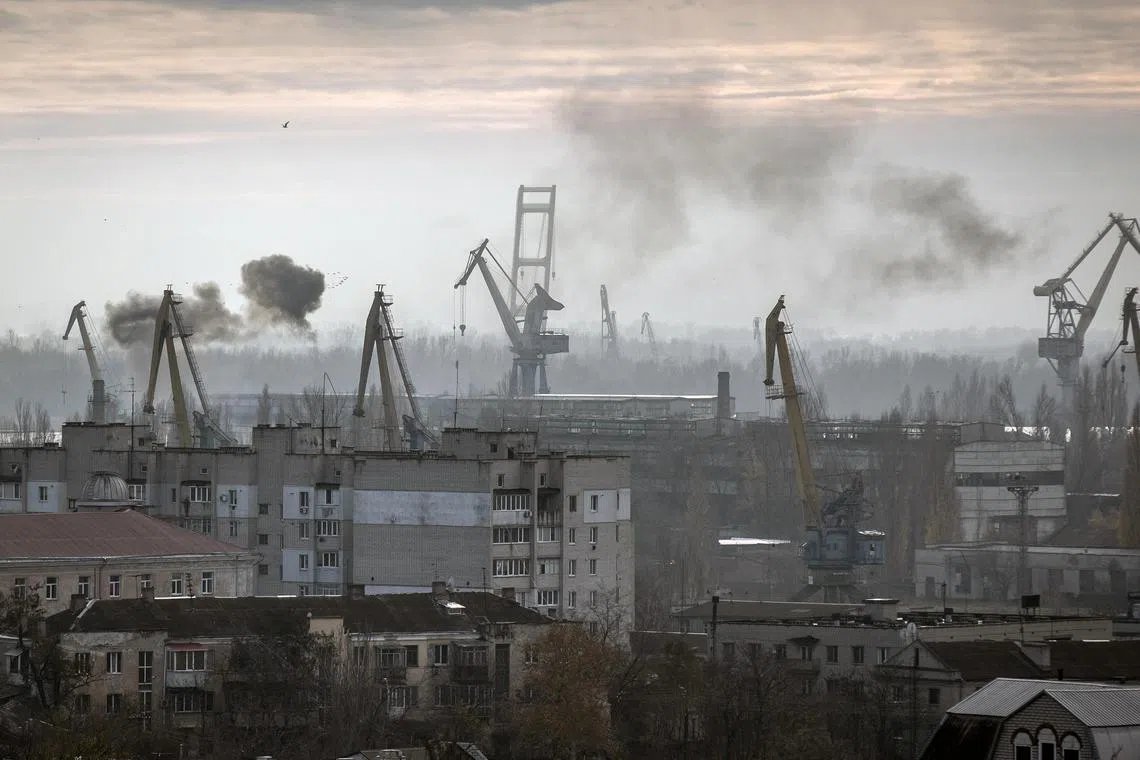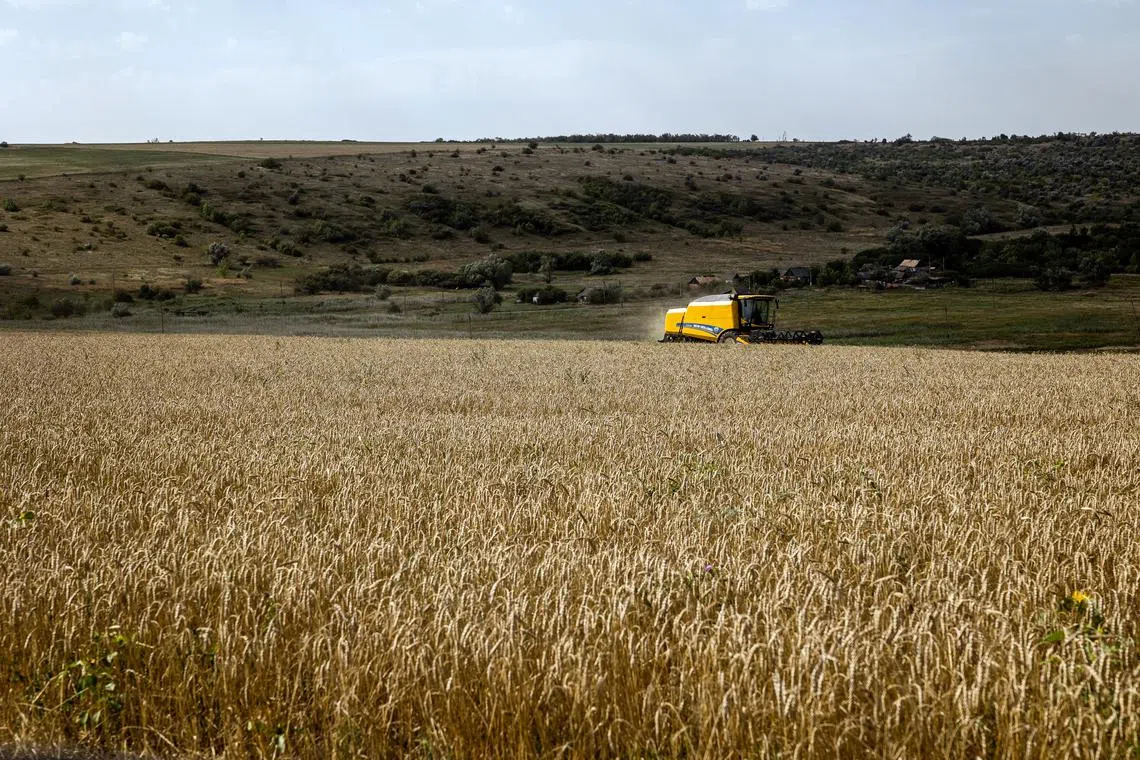How Russia’s war on Ukraine is worsening global starvation
Sign up now: Get ST's newsletters delivered to your inbox

Smoke rising during a Russian attack on the Ukrainian port of Kherson, on the Black Sea coast, on Nov 23, 2022.
PHOTO: NYTIMES
Follow topic:
ISTANBUL – Hulking ships carrying Ukrainian wheat and other grains are backed up along the Bosphorus Strait in Istanbul as they await inspections before moving on to ports around the world.
The number of ships sailing through this narrow strait, which connects Black Sea ports to wider waters, plummeted when Russia invaded Ukraine 10 months ago and imposed a naval blockade. Under diplomatic pressure, Moscow has begun allowing some vessels to pass, but it continues to restrict most shipments from Ukraine, which together with Russia once exported a quarter of the world’s wheat.
And at the few Ukrainian ports that are operational, Russia’s missile and drone attacks on Ukraine’s energy grid
An enduring global food crisis has become one of the farthest-reaching consequences of Russia’s war, contributing to widespread starvation, poverty and premature deaths.
The United States and allies are struggling to reduce the damage. US officials are organising efforts to help Ukrainian farmers get food out of their country through rail and road networks that connect to Eastern Europe and on barges travelling up the Danube River.
But as deep winter sets in and Russia presses assaults on Ukraine’s infrastructure, the crisis is worsening. Food shortages are already being exacerbated by a drought in the Horn of Africa
The United Nations World Food Programme estimates that over 345 million people are suffering from or at risk of acute food insecurity, more than double the number from 2019.
“We’re dealing now with a massive food insecurity crisis,” US Secretary of State Antony Blinken said last month at a summit with African leaders in Washington. “It’s the product of a lot of things... , as we all know,” he said, “including Russia’s aggression against Ukraine.”
The food shortages and high prices are causing intense pain across Africa, Asia and the Americas. US officials are especially worried about Afghanistan and Yemen, which have been ravaged by war.
Egypt, Lebanon and other big food-importing nations are finding it difficult to pay their debts and other expenses because costs have surged. Even in wealthy countries such as the US and Britain, soaring inflation driven in part by the war’s disruptions has left poorer people without enough to eat.
“By attacking Ukraine, the breadbasket of the world, (Russian President Vladimir) Putin is attacking the world’s poor, spiking global hunger when people are already on the brink of famine,” said Ms Samantha Power, administrator of the US Agency for International Development, or USAid.
Ukrainians are likening the events to the Holodomor
Mr Blinken said on Dec 20 that the US would begin granting blanket exceptions to its economic sanctions programmes worldwide to ensure that food aid and other assistance kept flowing. The action is intended to ensure that businesses do not withhold assistance for fear of running afoul of US sanctions.
State Department officials said it was the most significant change to US sanctions policy in years. The UN Security Council adopted a similar resolution on sanctions last month.

Wheat grain is seen on the MV Brave Commander from Ukraine, in the drought-stricken Horn of Africa as it docks at the port of Djibouti in Djibouti on Aug 30, 2022.
PHOTO: REUTERS
But Russia’s intentional disruption of global food supplies poses an entirely different problem.
Moscow has restricted its own exports, increasing costs elsewhere. Most important, it has stopped sales of fertiliser, needed by the world’s farmers. Before the war, Russia was the biggest exporter of fertiliser.
Its hostilities in Ukraine have also had a major effect. From March to November, Ukraine exported an average of 3.5 million tonnes of grains and oilseeds per month, a steep drop from the five million to seven million tonnes per month it exported before the war began in February, according to data from the country’s Ministry of Agrarian Policy and Food.
That number would be lower if not for a deal forged in July by the UN, Turkey, Russia and Ukraine,
Russia continues to block seven of the 13 ports used by Ukraine. Ukraine has 18 ports, but five are in Crimea, which Russia seized in 2014. Besides the three on the Black Sea, three on the Danube are operational.
The initial deal was only for four months, but was extended in November for another four months. When Russia threatened to leave it in October,
“The effects of this war are hugely, hugely disruptive,” she said. “Putin is pushing millions of people into poverty.”
While increases in the price of food last year have been particularly sharp in the Middle East, North Africa and South America, no region has been immune.
“You’re looking at price increases of everything from 60 per cent in the US to 1,900 per cent in Sudan,” said Ms Sara Menker, chief executive of Gro Intelligence which tracks food prices.

From March to November, Ukraine exported an average of 3.5 million tonnes of grains and oilseeds, a drop from the five to seven million tonnes per month before the war.
PHOTO: NYTIMES
Before the war, food prices had climbed to their highest levels in over a decade because of pandemic disruptions in the supply chain and pervasive drought.
The US, Brazil and Argentina, key grain producers for the world, have experienced three consecutive years of drought. The level of the Mississippi River fell so much that the barges that carry American grain to ports were temporarily grounded.
The weakening of many foreign currencies against the US dollar has also forced some countries to buy less food on the international market than in years past.
“There were a lot of structural issues, and then the war just made it that much worse,” Ms Menker said.
Over the last six months, food prices have retreated from highs reached in the spring, according to an index compiled by the United Nations. But they remain much higher than in previous years.
An uncertainty for farmers this winter is the soaring price of fertiliser, one of their biggest costs.
Farmers have passed on the higher cost by increasing the price of food products. And many farmers are using less fertiliser in their fields. That will result in lower crop yields in the coming seasons, pushing food prices higher.
Subsistence farms, which produce nearly a third of the world’s food, are being hit harder, Ms Coleman said.
In a communique issued at the close of their meeting in Bali, Indonesia, in November, leaders of the Group of 20 leading rich and developing nations said they were deeply concerned by the challenges to global food security and pledged to support the international efforts to keep food supply chains functioning.
“We need to strengthen trade cooperation, not weaken it,” Dr Ngozi Okonjo-Iweala, director-general of the World Trade Organisation, said at the summit.
The US government spends about US$2 billion (S$2.7 billion) per year on global food security, and it started a program called Feed the Future after the last big food crisis, in 2010, that now encompasses 20 countries.
Since the start of the Ukraine war, the US has provided more than US$11 billion to address the food crisis. That includes a US$100 million programme called AGRI-Ukraine, which has helped about 13,000 farmers in Ukraine – 27 per cent of the total – gain access to financing, technology, transportation, seeds, fertiliser, bags and mobile storage units, Ms Coleman said.
The efforts could help rebuild the country while alleviating the global food crisis – one-fifth of Ukraine’s economy is in the agriculture sector, and a fifth of the country’s labour force is connected to it.
“It’s hugely important for Ukraine’s economy,” she said, “and for Ukraine’s economic survival.” NYTIMES

